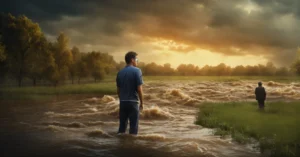Golf is a sport that’s often associated with sunny days, lush green fairways, and clear skies. But what happens when the weather takes a turn? Can you still play golf in the rain? The short answer is yes, and in fact, it can be quite an enjoyable experience if you’re prepared. Let’s dive into the world of rainy-day golf and discover how to make the most of it.
Understanding Golf in the Rain
Why Play Golf in the Rain?
Why would anyone want to play golf in the rain, you ask? Well, for some, it’s about the challenge. Rain adds a new layer of difficulty to the game, testing your skills in ways that a dry day simply can’t. For others, it’s about the tranquility. The course is often less crowded, giving you a peaceful, almost serene experience.
The Unique Challenges
Rain changes the dynamics of the game. Wet conditions can affect everything from your grip on the club to the way the ball moves on the green. This means you have to adapt your strategy and techniques, making it a true test of your adaptability and skill.
The Thrill of Rainy-Day Golf
There’s also a certain thrill that comes with playing in the rain. It’s an adventure, a break from the norm. The sound of raindrops hitting your umbrella, the fresh smell of rain-soaked grass, and the cool, refreshing air can make for a unique and invigorating experience.
Can You Play Golf in the Rain?

You definitely can play golf in the rain, though with some caveats. It can be a unique experience, with the course mostly for yourself and the greens receptive to softer landings. But it’s important to be prepared for the elements.
Here’s a breakdown of playing golf in the rain:
Pros:
- Less crowded course: Rain deters many golfers, giving you more space and potentially a faster pace of play.
- Softer greens: Rain makes the putting surfaces softer, allowing for better ball control and stopping power.
Cons:
- Uncomfortable conditions: Obviously, getting wet and cold can be unpleasant.
- Playing adjustments: The wet course affects shot distance and grip. You’ll need to adjust your club selection and swing for less roll and potentially more skid.
- Safety hazards: Lightning is a major concern. If there’s any lightning activity, prioritize safety and seek shelter.
Before you head out:
- Check the forecast: Look for consistent rain instead of downpours or thunderstorms.
- Gear up: Waterproof clothing, rain gloves, and a good umbrella are essential. Bring extra towels to dry clubs and grips.
- Course policy: Some courses might have restrictions on playing during rain. Check their policy beforehand.
Ultimately, playing in the rain comes down to personal preference. If you’re prepared and comfortable with the conditions, it can be a fun way to experience the course differently. But safety should always be your top priority.
Read also:
Do people still play golf in the rain?

Yes, people still play golf in the rain! There are some advantages to it, like having the course mostly to yourself and the greens being softer so the ball stops quicker. Of course, you need to be prepared with rain gear and adjust your game a bit for the wet conditions.
Here are some things to consider:
- Safety first: Lightning is the main concern. If there’s any lightning around, don’t even think about golfing – head inside for shelter.
- Gear up: Rain gear, extra towels, and waterproof gloves are essential.
- Course conditions: The course will be softer and the ball won’t roll as far. You might need to adjust your club selection.
- Enjoy the peace and quiet: There will likely be fewer golfers out on a rainy day, so you can enjoy a more relaxing round.
So, if you don’t mind getting a little wet, golfing in the rain can be a fun and rewarding experience.
Do professional golfers play in the rain
Yes, professional golfers do play in the rain, although with some considerations. Tournaments rarely get cancelled solely due to rain. Here’s why:
-
Million dollar purses: There’s a lot of money on the line, and golfers are determined to compete for it, even in less than ideal conditions.
-
Adaptability is key: Being able to adjust your game to different weather conditions is a crucial skill for professional golfers. Rain requires strategic thinking and shot adjustments, which showcases their talent.
-
Tournaments often have rain delays: Play might be suspended for a while if the rain is heavy, but it usually resumes once conditions improve slightly.
Of course, safety is paramount. If there’s lightning or extreme weather, officials will halt play.
How to play golf in the rain?

Playing golf in the rain can be a challenge, but with the right approach, it can also be a rewarding experience. Here are some tips to help you conquer the course on a wet day:
Gear Up for the Elements:
- Waterproof clothing: This is a no-brainer. Invest in a good rain jacket and pants that will keep you dry throughout the round.
- Rain gloves: Regular leather gloves will get slippery when wet. Opt for rain gloves designed to maintain grip in wet conditions.
- Footwear: Shoes with soft spikes will provide better traction on wet grass. Avoid spikeless shoes, which can be slippery.
- Towels: Pack a couple of extra towels to dry your clubs and grips after each shot.
- Umbrella: A double-canopy umbrella offers superior protection from wind and rain.
Adjust Your Game:
- Club selection: The course will play longer due to reduced roll. Consider taking one extra club for most shots.
- Swing mechanics: You might need to adjust your swing for less roll and potentially more skid. Focus on a more controlled swing with good wrist control.
- Shorter backswing: A shorter backswing can help maintain balance and control in wet conditions.
- Putting: Greens will be slower. Hit your putts firmer with a longer backswing to compensate for the reduced pace.
- Ball position: For chip shots, consider positioning the ball slightly back in your stance to promote a higher launch and softer landing.
Course Awareness and Safety:
- Course rules: Some courses have restrictions on playing during heavy rain. Check with the course beforehand.
- Embedded balls: If your ball becomes embedded due to the soft ground, you can take relief without penalty under current golf rules.
- Lightning: This is the most important safety concern. If there’s any lightning activity, immediately stop playing and seek shelter.
Bonus Tip:
- Keep a positive attitude: Embrace the challenge and enjoy the unique experience of playing golf in the rain.
By following these tips and prioritizing safety, you can navigate the wet course and potentially even have a great round of golf!
Read also: How to Clean a Golf Cap?
Preparing for a Rainy Round

1. Essential Rain Gear
To make the most of your rainy-day golf, you need the right gear. Here’s a breakdown of what you’ll need:
2. Waterproof Clothing
First and foremost, invest in good waterproof clothing. A quality rain jacket and pants will keep you dry and comfortable, allowing you to focus on your game rather than the weather.
3. Rain Gloves
Regular golf gloves can become slippery when wet, making it hard to maintain a good grip. Rain gloves are designed to perform better in wet conditions, ensuring you can keep a firm hold on your club.
4. Waterproof Golf Shoes
Keeping your feet dry is crucial for comfort and stability. Waterproof golf shoes will prevent your feet from getting soaked, reducing the risk of blisters and discomfort.
5. Gear Maintenance
Taking care of your gear is just as important as having the right equipment.
6. Keeping Clubs Dry
Wet clubs can affect your grip and swing. Keep a towel handy to dry your clubs and grips regularly throughout your round.
7. Protecting Your Bag
A waterproof bag cover is a must to keep your clubs and other belongings dry. This will help prevent any damage and ensure your equipment stays in good condition.
Read also: Can You Wash Golf Gloves?
Adapting Your Game to Wet Conditions
Adjusting Your Swing
Wet conditions can make the ground softer and your stance less stable. Focus on maintaining your balance and making smoother, more controlled swings.
Reading Wet Greens
Greens can become slower and more unpredictable when wet. Take the time to read the greens carefully and adjust your putting speed accordingly.
Club Selection in the Rain
The ball doesn’t travel as far in the rain, so you might need to use a longer club than usual. Pay attention to how the rain affects your shots and choose your clubs accordingly.
Safety Considerations
Course Management in the Rain
Understanding Course Conditions
Rain can drastically change the condition of the course. Be mindful of wet fairways, mud, and puddles, and adjust your game plan accordingly.
Navigating Wet Fairways
Wet fairways can slow down your ball and make it harder to get good roll. Aim to hit higher, cleaner shots to avoid getting stuck in the mud.
Managing Mud and Puddles
Mud and puddles can be a nuisance, but they can also provide opportunities to improve your skills. Learn how to play around these obstacles and use them to your advantage.
Benefits of Playing in the Rain
Less Crowded Courses
One of the biggest advantages of playing in the rain is the reduced crowd. You’ll often find the course much quieter, allowing you to enjoy a more relaxed round.
Improved Skills
Playing in the rain can improve your skills significantly. It forces you to adapt and think on your feet, which can make you a better, more versatile golfer.
Mental Toughness
Facing the elements builds mental toughness. It teaches you perseverance and resilience, qualities that are invaluable both on and off the course.
Conclusion
Embrace the challenge of playing golf in the rain. With the right preparation and mindset, it can be a rewarding and enjoyable experience. So next time the clouds roll in, don’t pack up your clubs—get out there and play!
FAQs:
1. Can I play golf in heavy rain?
Yes, but it’s important to prioritize safety. If there’s lightning or extremely heavy rain, it’s best to wait until conditions improve.
2. How do I keep my grips dry?
Use a towel to regularly dry your grips and consider using rain gloves designed for wet conditions.
3. What should I do if there is lightning?
Stop playing immediately and seek shelter. It’s not safe to play during a thunderstorm.
4. Are golf courses open during the rain?
Most courses remain open in light to moderate rain, but heavy rain or thunderstorms may cause temporary closures.
5. Does rain affect ball distance?
Yes, rain can reduce the distance your ball travels. The wet conditions make the ball heavier and less aerodynamic.










